Scenes from a fake emergency
School of Nursing students learn by doing in a disaster simulation, complete with blood, chaos, and interfering bystanders.
By Cathy Shufro
|
Mar/Apr 2021
Cathy Shufro teaches writing at Yale.
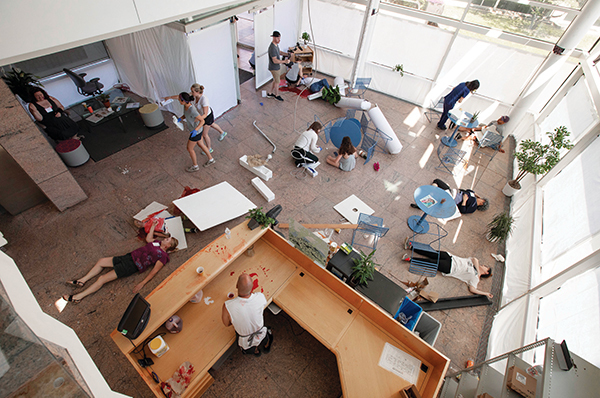 Bob HandelmanAs students enter the scene, they can hear the sirens of approaching ambulances. The room is smoky. Some of the café customers are screaming. The students’ first task is to find everyone who is injured.
There will be four iterations of this collapsed-ceiling disaster, and in all, 118 students will participate. Now they’ll find out how well they do in this kind of crisis.
View full image Bob HandelmanAs students enter the scene, they can hear the sirens of approaching ambulances. The room is smoky. Some of the café customers are screaming. The students’ first task is to find everyone who is injured.
There will be four iterations of this collapsed-ceiling disaster, and in all, 118 students will participate. Now they’ll find out how well they do in this kind of crisis.
View full image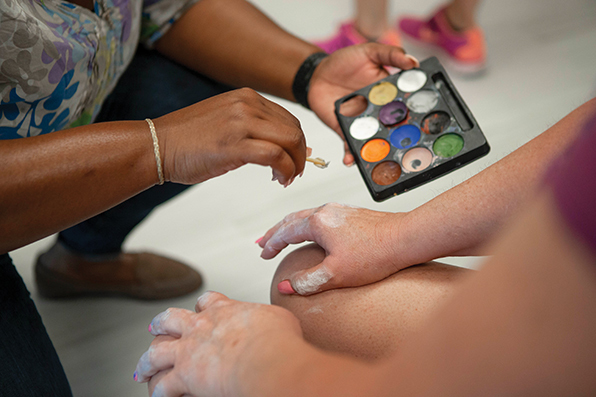 Bob HandelmanExpenditures for make-up, fake blood, and wigs all came to under $100, because Pranger scours post-Halloween sales. She borrowed a Starbucks sign for the café and found pinnies for the rescue team at a thrift store.
View full image Bob HandelmanExpenditures for make-up, fake blood, and wigs all came to under $100, because Pranger scours post-Halloween sales. She borrowed a Starbucks sign for the café and found pinnies for the rescue team at a thrift store.
View full image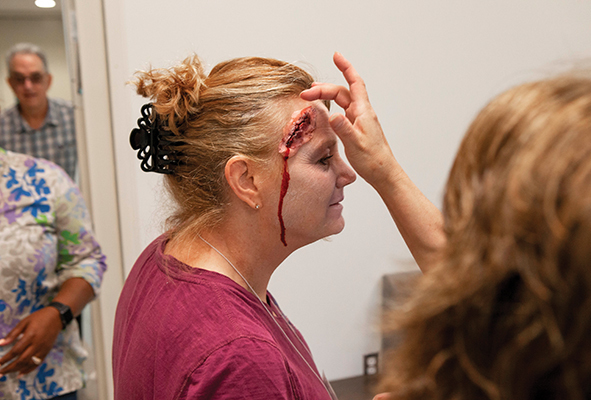 Bob HandelmanThis patient’s gruesome brain injury will prove fatal. In real life, she is nursing school senior administrative assistant Christine Kendzierski. Other victims include advanced students, recent graduates, and the teenaged daughters of lecturer Virginia Sherrick.
View full image Bob HandelmanThis patient’s gruesome brain injury will prove fatal. In real life, she is nursing school senior administrative assistant Christine Kendzierski. Other victims include advanced students, recent graduates, and the teenaged daughters of lecturer Virginia Sherrick.
View full image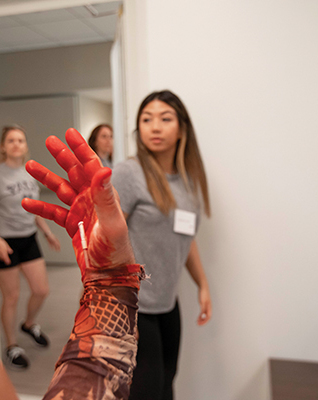 Bob HandelmanSamantha Salas ’20MSN seems unfazed by the bloodied arm of Jake Thomas ’19MSN. Thomas, who plays the part of a café barista, is now a family nurse practitioner.
View full image Bob HandelmanSamantha Salas ’20MSN seems unfazed by the bloodied arm of Jake Thomas ’19MSN. Thomas, who plays the part of a café barista, is now a family nurse practitioner.
View full image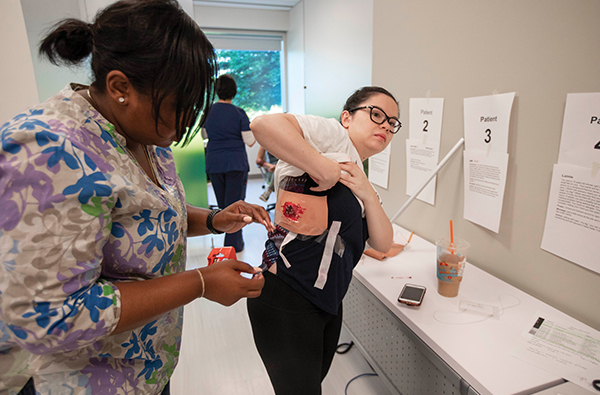 Bob HandelmanSamantha Copeland ’20MSN gets ready to portray the customer with the chest wound. The “wound” is made of skin from a defunct manikin.
View full image Bob HandelmanSamantha Copeland ’20MSN gets ready to portray the customer with the chest wound. The “wound” is made of skin from a defunct manikin.
View full image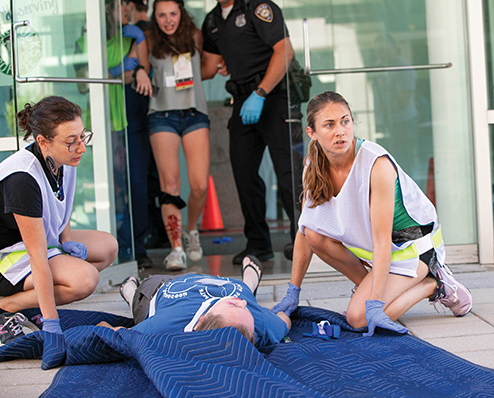 Bob HandelmanSasha Susman ’21MSN (left) and Maureen May ’21MSN watch over an unconscious teenager with a head injury.
View full image Bob HandelmanSasha Susman ’21MSN (left) and Maureen May ’21MSN watch over an unconscious teenager with a head injury.
View full image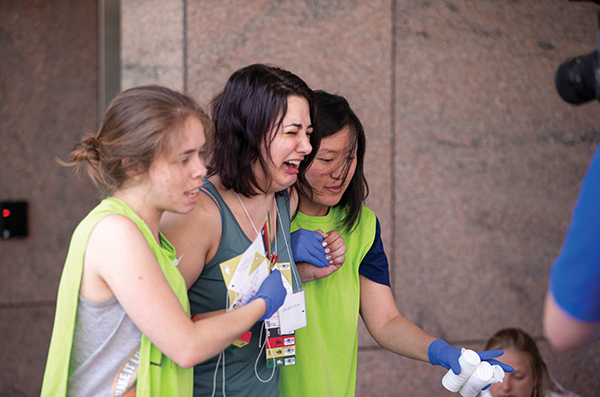 Bob HandelmanStudents Amelie Aguilar ’21MSN, left, and Luanyi Li ’21MSN, right, escort a victim to safety. The woman’s green tag indicates that she has no serious injuries—but the students will seek to relieve her distress.
View full image Bob HandelmanStudents Amelie Aguilar ’21MSN, left, and Luanyi Li ’21MSN, right, escort a victim to safety. The woman’s green tag indicates that she has no serious injuries—but the students will seek to relieve her distress.
View full image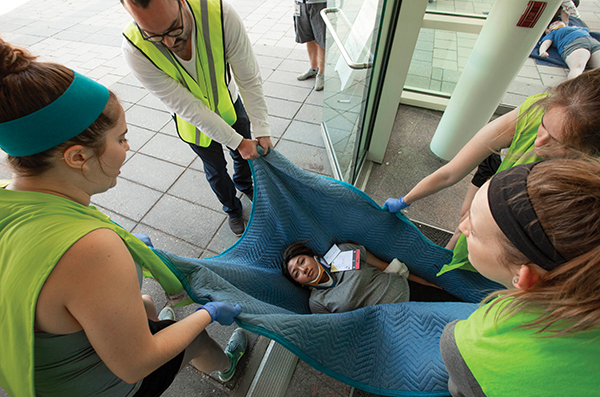 Bob HandelmanThis victim has a head injury and is having seizures. The students had waited for a cervical collar to stabilize her spine before moving her out. After the exercise, Alanna Sade-Milberg ’21MSN will remember asking herself: “Do I move her and risk more damage, or do I wait for other people to come and help me move her?” During the debriefing, she realizes, “I never—not once—thought, ‘Oh, this [ceiling collapse] could happen again if we don’t get them out fast enough.’ The police told us we should have gotten them out way faster.”
View full image Bob HandelmanThis victim has a head injury and is having seizures. The students had waited for a cervical collar to stabilize her spine before moving her out. After the exercise, Alanna Sade-Milberg ’21MSN will remember asking herself: “Do I move her and risk more damage, or do I wait for other people to come and help me move her?” During the debriefing, she realizes, “I never—not once—thought, ‘Oh, this [ceiling collapse] could happen again if we don’t get them out fast enough.’ The police told us we should have gotten them out way faster.”
View full image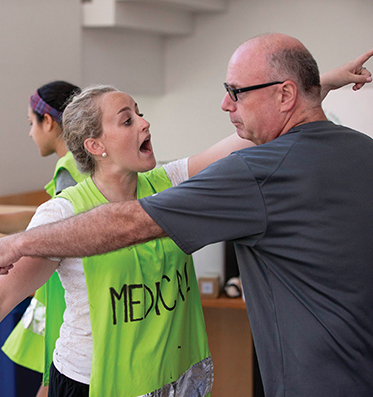 Bob HandelmanAnother participant plays the part of a bystander who wandered into the café and has been interfering and amping up anxiety—“That girl’s bleeding out of her head! She needs help! Is she dead?” Here, Audrey Webb ’21MSN is doing the right thing: ordering him out. He’ll leave, but only for a while. Even after a police officer asks him to sit outside and talk with the patients awaiting transport, he keeps coming back. Finally, the police will handcuff him.
View full image Bob HandelmanAnother participant plays the part of a bystander who wandered into the café and has been interfering and amping up anxiety—“That girl’s bleeding out of her head! She needs help! Is she dead?” Here, Audrey Webb ’21MSN is doing the right thing: ordering him out. He’ll leave, but only for a while. Even after a police officer asks him to sit outside and talk with the patients awaiting transport, he keeps coming back. Finally, the police will handcuff him.
View full image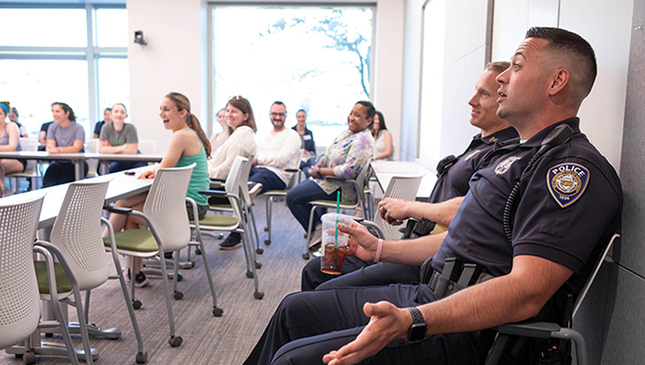 Bob HandelmanAfter the exercise comes the debriefing. “I had no idea how to interact with the police,” one student says. Yale Police officer R. DeJesus (far right) says students should have oriented him. “Was there a bomb? Earthquake? We don’t know what’s going on,” he says. “Our main thing is, you guys aren’t getting hurt while you’re doing your job.” He adds, “We liked being told what to do, not standing there with the doughnut crumbs.”
View full image Bob HandelmanAfter the exercise comes the debriefing. “I had no idea how to interact with the police,” one student says. Yale Police officer R. DeJesus (far right) says students should have oriented him. “Was there a bomb? Earthquake? We don’t know what’s going on,” he says. “Our main thing is, you guys aren’t getting hurt while you’re doing your job.” He adds, “We liked being told what to do, not standing there with the doughnut crumbs.”
View full image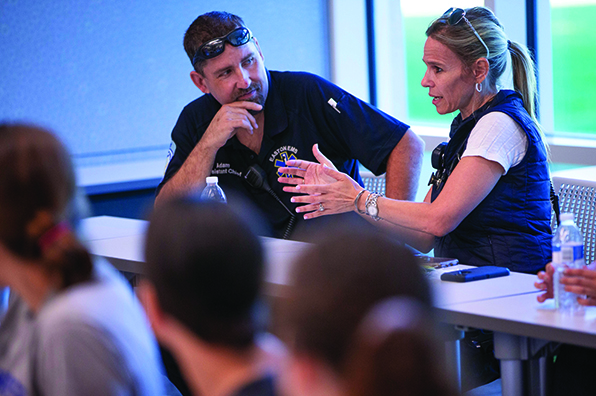 Bob HandelmanParamedic Leigh Goodman (right) warns students against reassuring someone who has a serious injury. “You need them to trust you, so if you look at someone who is clearly dying and you say they’re OK, they’re not going to trust anything you’re going to say,” says Goodman, who directs EMS in Trumbull, Connecticut. At left is Adam Goldstein, assistant EMS chief in Easton.
During the discussion, the students agree that one key skill is to keep emotions in check. A teacher recom-mends that rescuers tell themselves, “OK, this is really stressful, but I need to be calm.”
Another student comments: “This is the first time I realized I can’t help everybody.”
View full image Bob HandelmanParamedic Leigh Goodman (right) warns students against reassuring someone who has a serious injury. “You need them to trust you, so if you look at someone who is clearly dying and you say they’re OK, they’re not going to trust anything you’re going to say,” says Goodman, who directs EMS in Trumbull, Connecticut. At left is Adam Goldstein, assistant EMS chief in Easton.
During the discussion, the students agree that one key skill is to keep emotions in check. A teacher recom-mends that rescuers tell themselves, “OK, this is really stressful, but I need to be calm.”
Another student comments: “This is the first time I realized I can’t help everybody.”
View full image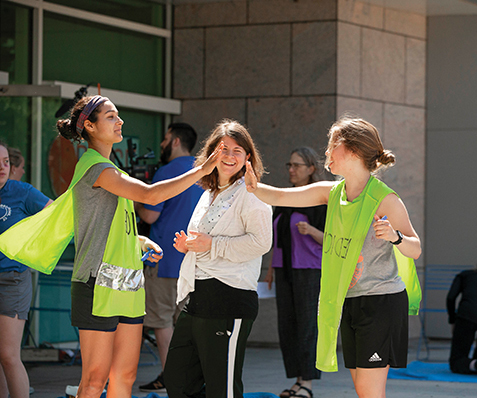 Bob HandelmanCelebrating the end of the simulation are Madison Herel, Anna Bristow (center), and Amelie Aguilar, all ’21MSN. Afterwards, “I was still riding the adrenaline rush,” says student Audrey Webb ’21MSN. “It was really awesome to say, as I walked out of this building, ‘I know how to triage, I know how to talk to DMAT [the disaster management assistance team], I know how to talk to EMS.’”
View full image Bob HandelmanCelebrating the end of the simulation are Madison Herel, Anna Bristow (center), and Amelie Aguilar, all ’21MSN. Afterwards, “I was still riding the adrenaline rush,” says student Audrey Webb ’21MSN. “It was really awesome to say, as I walked out of this building, ‘I know how to triage, I know how to talk to DMAT [the disaster management assistance team], I know how to talk to EMS.’”
View full imageTo our readers:
We had planned to publish this feature article a year ago. But then came the pandemic, and we felt that a time of sudden anxiety and changes wasn’t the right time for blood and wounds—even imitation blood and wounds. Now that the COVID vaccine is being administered to more people more quickly, we’re finally publishing this article about how nurses learn their discipline.
And while we’re on the subject: we are dedicating this article to every nurse who has cared for a COVID patient. Thank you for the care you’ve given to people in need.—The Editors
Forty-eight hours ago, School of Nursing lecturer Shannon Pranger was in this building on Yale’s West Campus, laying out tubes of fake blood, wigs, and make-up to transform a dozen volunteers into victims. They would look injured—or in one case, dead—in the simulated disaster shown here: a coffee-shop ceiling that collapsed on customers. Their rescuers would be students at the School of Nursing.
One victim would stand out, Pranger had said: a man with a metal pole embedded in his thigh. An impalement will remain stable if no one tampers with it. She hoped the students would stabilize and evacuate the worse-off victims before the man with the pole. “He has a big, exciting wound,” said Pranger. “But is he a priority? He’s a distraction.”
A sucking chest wound is another matter, she’d said, holding up a hand-sized patch of artificial skin, painted with fake blood to indicate a punctured lung. A volunteer wearing ghostly pale foundation would tape the wound on her ribcage and wear a tag around her neck reading “cap refill > 2 , R 0.” That would inform the students that her circulation, or capillary refill, was so impaired by her injury that she is close to death. Her R, or respiration, would be zero—but, confusingly, she would gasp for breath occasionally. Would the students recognize that immediate treatment could save her life? In a classroom, they surely would. But in a scene of chaos? “There will be blood everywhere,” Pranger said, cheerily.
The focus of the exercise will be good communication, she added. The students, who have all finished the first year in their three-year master’s program, must work in teams to figure out how to swiftly and safely move injured customers out of the ruined café and into the hands of emergency medical services (EMS).
Pranger, who left Yale for Sacred Heart University last summer, has helped oversee disaster simulations before, and she had a prediction: afterwards, at least one nursing student would say, “This is the first time I realized I can’t save everyone.” The student would probably be crying.
|
|
 loading
loading